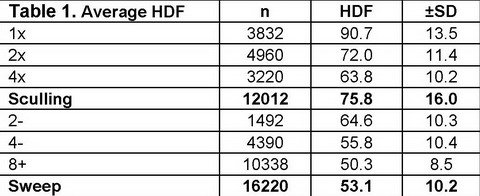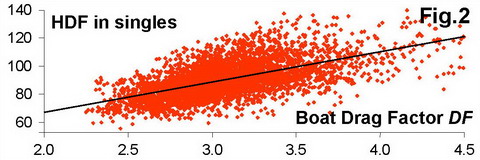Handle Drag Factor

In RBN 2011/01, Handle Drag Factor HDF was introduced as a measure of rowing “heaviness”- a “burden factor” of sorts. Here is further analysis of this indicator to make it more understandable and familiar for rowers and coaches. HDF was defined as a ratio of rowing power P to the cube of the average handle velocity over the drive Vh.av:
HDF = P / Vh.av3 = P / (L / Td)3 (1)
where L is the length of the arc travelled by the middle of the handle and Td is the drive time. The higher HDF is the “heavier” the rowing feels: more power is required to achieve the same handle speed, or the average handle speed is slower at the ame power.

HDF significantly vary in boat types (Table 1 shows averages of n=28232 BioRow measurements): in sculling it was 50% heavier than in sweep boats (because of longer catch angles and bigger total blade area), and it was heavier for small boats than for big ones (higher drag per rower). Males had about 15% higher HDF than females for the same reason (longer catch and higher weight - drag).

In all boat types, HDF becomes “lighter” at higher stroke rates (Fig.1): this is likely related to shorter catch angles at higher rates (see below). Rowers who maintain similar angles at all stroke rates usually do not have much variation of HDF.

What are the main factors affecting HDF? As it varies significantly across boat types, only singles were analysed in this newsletter. It was found that the highest correlation with HDF was the boat Drag Factor DF (r=0.61), which is understandable: higher external drag resistance (weather conditions or heavier crew) requires more power to pull the handle through with the same speed, or the handle speed is slower at the same power. For this reason, HDF showed positive correlation with crew weight (r=0.53). To eliminate the effect of the Drag Factor and find HDF relationships with other variables, the trend equation HDF(DF) was derived (Fig.2) and deviations of every data point dHDF from the trend were found.
Correlations of 200 biomechanical variables with dHDF were ranked, and significant relationships were found with absolute power indicators: work per stroke (r=0.52), max force (r=0.47) and average force (r=0.45), but it is likely due to the mutual correlation with another variable – the rower’s size affecting the drag factor. Bigger rowers produce higher power and also have higher drag, so higher HDF.
Correlation of dHDF with the catch angles was higher than with the gearing ratio (r=0.47 and r=0.29: the longer the catch or the higher outboard/inboard ratio – the higher HDF). The finish angles showed a small negative correlation (r=-0.15, longer finish – lower HDF), which could be related to the very common “artificial length” at the finish: when the rowers continue drive movement with blades out of water, no force and power is produced, but the handle speed is maintained, so HDF is “lighter”. The correlation with gearing ratio was affected by the outboard length only (r=0.28), not by the inboard (r=0.02). Based on the corresponding trends, every 1 deg longer catch angle and 1 cm longer outboard increased HDF by about 1.5 units.
The above findings were experimentally confirmed with measurements of technical drills: the same sculler with the same boat/oars and weather conditions had a very heavy HDF 140+ rowing the “catch only” drill with a long catch 70+ deg, but more than two times lighter HDF 60-70 with the “quarter slide” drill at 45-50deg catch angles.
Some interesting results gave analysis of the power distribution during the drive: power production during the first 1/3rd of the drive makes HDF lighter (r=-0.47), but more power during the last 1/3rd - makes it heavier (r=0.57). This was confirmed by positive correlation with the position of the peak force (r=0.22) and catch force gradient: the later the peak force – the heavier the HDF. The reasons for this phenomenon are not yet clear, but the data shows that a front-loaded drive feels faster and lighter; subsequently more power towards the finish makes the drive heavier.
Blade efficiency had a moderate positive correlation with dHDF (r=0.26, more efficient blade feels heavier), correlation with Catch Factor was quite small (r=0.11): catching “through the stretcher” makes HDF slightly lighter.
Many coaches are still looking for some “magic” rigging numbers and believe that tiny changes in oar length make a significant difference. However, results of this study show that catch angles and power application make similar or even more significant effects on stroke mechanics, rower’s feelings, drive time and stroke rate.
©2020 Dr. Valery Kleshnev www.biorow.com



